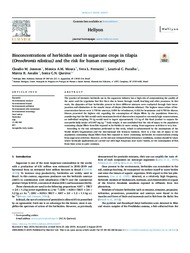Bioconcentrations of herbicides used in sugarcane crops in tilapia (Oreochromis niloticus) and the risk for human consumption.
Bioconcentrations of herbicides used in sugarcane crops in tilapia (Oreochromis niloticus) and the risk for human consumption.
Author(s): JONSSON, C. M.; MOURA, M. A. M. de; FERRACINI, V. L.; PARAIBA, L. C.; ASSALIN, M. R.; QUEIROZ, S. C. do N. de
Summary: The practice of intensive herbicide use in the sugarcane industry has a high risk of compromising the quality of the water and the organisms that live there due to losses through runoff, leaching and other processes. In this work, the dynamics of four herbicides present in three different mixtures were evaluated through their incor- poration and elimination in the muscle tissue of tilapia (Oreochromis niloticus). The highest mean values of bio- concentration factors were 1.730 for ametryn, 0.891 for tebuthiuron, 0.322 for hexazinone and 4.783 for diuron. Diuron presented the highest risk regarding the consumption of tilapia fillets by the population. However, considering that the fish would reach maximum levels of diuron when exposed to extremely high concentrations, an individual weighing 70 kg would need to ingest approximately 1.5 kg of this food product to surpass the acceptable daily intake of 0.007 mg kg 1 body weight. It was concluded that the risk of injury to the population consuming tilapia fillets from fish exposed to herbicides in water arising from sugarcane activities is very low. According to the risk estimation performed in this work, which is substantiated by the assumptions of the World Health Organization and the International Life Sciences Institute, there is a low risk of injury to the population consuming tilapia fillets from fish exposed to water containing herbicides in concentrations arising from sugarcane activities. However, as the risk was estimated from laboratory conditions, caution should be taken where herbicide applications are carried out with high frequency near water bodies, as the consumption of fish from these areas is quite common.
Publication year: 2019
Types of publication: Journal article
Unit: Embrapa Environment
Observation
Some of Embrapa's publications are published as ePub files. To read them, use or download one of the following free software options to your computer or mobile device. Android: Google Play Books; IOS: iBooks; Windows and Linux: Calibre.
Access other publications
Access the Agricultural Research Database (BDPA) to consult Embrapa's full library collection and records.
Visit Embrapa Bookstore to purchase books and other publications sold by Embrapa.

